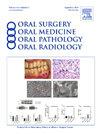A systematic review and meta-analysis on the use of regenerative graft materials for socket preservation in randomized clinical trials
IF 2
3区 医学
Q2 DENTISTRY, ORAL SURGERY & MEDICINE
Oral Surgery Oral Medicine Oral Pathology Oral Radiology
Pub Date : 2024-07-18
DOI:10.1016/j.oooo.2024.07.003
引用次数: 0
Abstract
Objective
To evaluate if regenerative materials with/without scaffold deployed in dental socket preservation led to reduced radiographic height and width bone resorption.
Study design
English-written human studies from January 2010 to December 2023 were selected from PubMed, EMBASE, MEDLINE, Cochrane CENTRAL, Google Scholar and manually searched journals. Six meta-analyses were conducted, addressing treatments with all blood-derived growth factor preparations as well as L-platelet-rich fibrin (L-PRF) separately, and recombinant human BMP-2 (rhBMP-2). An unpaired t-test on L-PRF and rhBMP-2 determined the clinically best preservation treatment. Cochrane risk of bias in all studies was analyzed.
Results
Twenty-nine articles (1068 participants) were included. Meta-analyses on blood-derived preparations demonstrated nonsignificant alveolar width, but significant (p = .001) height preservation. L-PRF vs. natural healing demonstrated nonsignificant changes in both dimensions. RhBMP-2 caused highly significant reduced horizontal (p = .01) and vertical (p < .0008) bone resorptions. When comparing mean resorption rates, significant benefits of rhBMP-2 over L-PRF were observed for width but not height preservation (p < .0001 and p = .057, respectively). Six studies recorded low, 8 moderate, and 15 high net risks.
Conclusions
Regenerative materials appear beneficial for radiographic bone width and height preservation after tooth extraction. Although rhBMP-2 performed better in alveolar width preservation, L-PRF can be an autologous and cost-effective alternative.
关于在随机临床试验中使用再生植骨材料进行牙槽窝保存的系统回顾和荟萃分析
评估在牙槽窝保存中使用带/不带支架的再生材料是否会减少放射线高度和宽度骨吸收。研究人员从 PubMed、EMBASE、MEDLINE、Cochrane CENTRAL、Google Scholar 和人工搜索的期刊中筛选出 2010 年 1 月至 2023 年 12 月期间的英文人类研究。共进行了六项荟萃分析,分别探讨了所有血源性生长因子制剂、L-富血小板纤维蛋白(L-PRF)和重组人BMP-2(rhBMP-2)的治疗方法。通过对 L-PRF 和 rhBMP-2 进行非配对 t 检验,确定了临床上最佳的保存治疗方法。对所有研究的科克伦偏倚风险进行了分析。共纳入 29 篇文章(1068 名参与者)。关于血源性制剂的 Meta 分析表明,牙槽宽度的保存效果不显著,但高度的保存效果显著(= 0.001)。L-PRF 与自然愈合相比,两个维度的变化都不显著。RhBMP-2 可显著减少水平(= 0.01)和垂直(< 0.0008)骨吸收。在比较平均骨吸收率时,观察到 rhBMP-2 比 L-PRF 在保持宽度方面有显著优势,但在保持高度方面则没有(分别为 < 0.0001 和 = 0.057)。6项研究记录了低净风险,8项为中度,15项为高度。再生材料似乎有利于拔牙后放射骨宽度和高度的保存。虽然 rhBMP-2 在保留牙槽宽度方面表现更好,但 L-PRF 可以作为一种自体的、具有成本效益的替代材料。
本文章由计算机程序翻译,如有差异,请以英文原文为准。
求助全文
约1分钟内获得全文
求助全文
来源期刊

Oral Surgery Oral Medicine Oral Pathology Oral Radiology
DENTISTRY, ORAL SURGERY & MEDICINE-
CiteScore
3.80
自引率
6.90%
发文量
1217
审稿时长
2-4 weeks
期刊介绍:
Oral Surgery, Oral Medicine, Oral Pathology and Oral Radiology is required reading for anyone in the fields of oral surgery, oral medicine, oral pathology, oral radiology or advanced general practice dentistry. It is the only major dental journal that provides a practical and complete overview of the medical and surgical techniques of dental practice in four areas. Topics covered include such current issues as dental implants, treatment of HIV-infected patients, and evaluation and treatment of TMJ disorders. The official publication for nine societies, the Journal is recommended for initial purchase in the Brandon Hill study, Selected List of Books and Journals for the Small Medical Library.
 求助内容:
求助内容: 应助结果提醒方式:
应助结果提醒方式:


